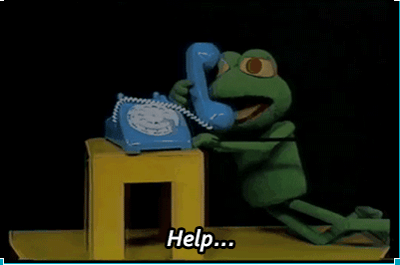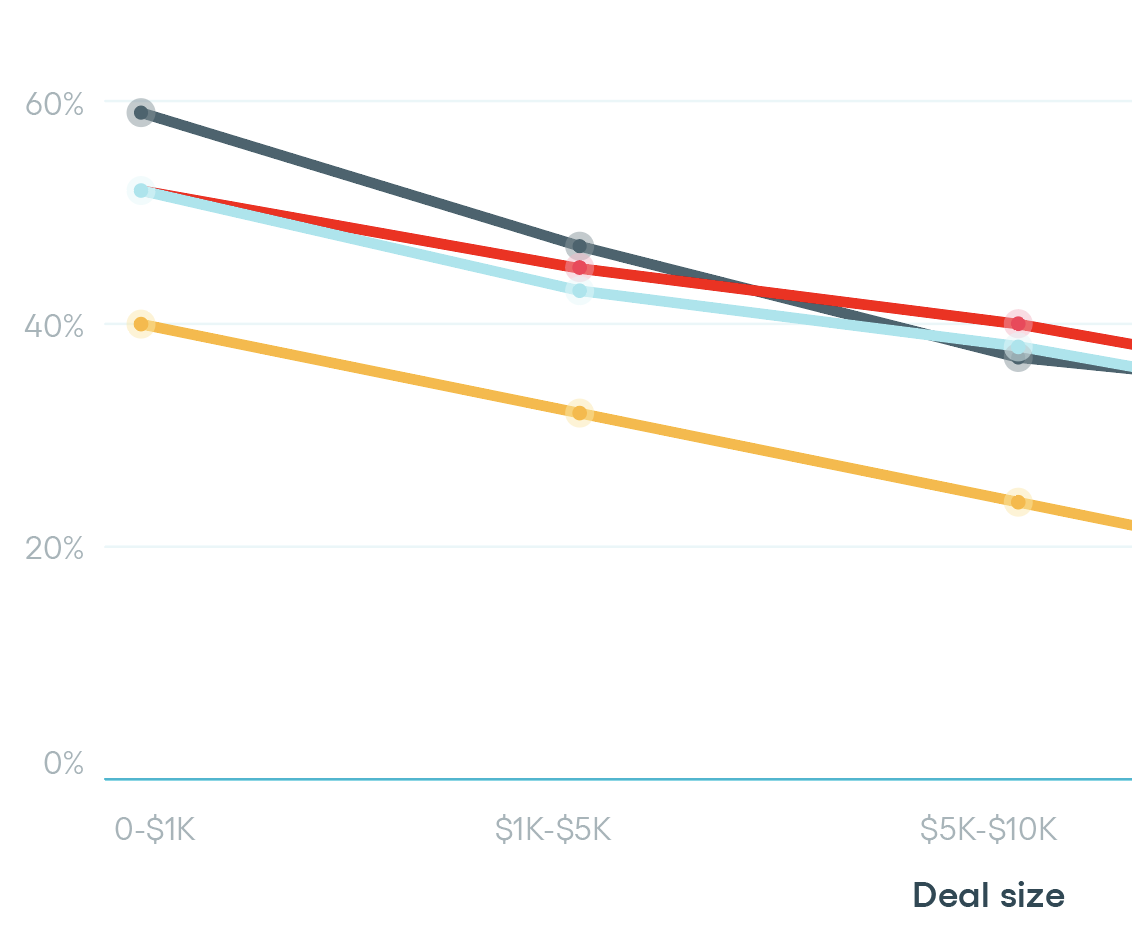
Understanding your sales lead doesn’t happen by chance. It takes time, research, and a lot of asking the right questions to uncover your customers' needs. Here are 10 of the best open-ended sales questions, plus how to structure your discovery process around them.
Anxiety, excitement, nervousness, intrigue.
When I worked as a Sales Development Representative (SDR), those were the feelings that would usually bubble up inside me before making a first call to a potential customer.
I used to really struggle with getting customers to answer cold-calls and open up about their needs. It was frustrating at the time because it made it difficult to both qualify the lead or close a deal. How could I sell someone something when I didn’t even know what they needed or what their problems were? I’ve since learned that if I had changed my angle or the way I asked my sales qualifying questions, I would have had more success.

As it turns out, the secret to getting someone to open up about themselves is all in the wording. By asking a variety of open-ended sales questions, you’ll discover the nuts and bolts of who your customer is, why they need your help, and whether or not your solution will be a good fit.
What is an open-ended question in sales?
If you’re the queen or king of conversation, you likely already know a thing or two about open-ended questions and how to get people talking. But if you feel like most people respond with one-word answers that take you nowhere, it’s probably time to change your approach.
So what exactly is an open-ended sales question?
In sales, open-ended questions can be called a few different things; sales discovery questions, customer interview questions, qualifying questions, or even sales probing questions. They all mean the same thing, and refer to questions you ask a customer during a first conversation that allow you to understand the customer better.
Say I started a conversation with you, and asked, “Are you feeling better today?” Based on how I phrased the question, you’re probably going to respond with a one or two-word answer.
The question is close-ended because it doesn’t invite you to say anything more, to elaborate, to provide more detail; it pigeonholes you into a preset, yes/no answer. It also doesn’t give me, as the asker of the question, much room for follow-up.
Had I started the same conversation with, “How are you feeling today?” it invites you to tell me more. It gives you creative liberty to lead the conversation in a direction that perhaps I wasn’t expecting and provides more information.
Why do open-ended sales questions work?
The power of an open-ended sales question is based on how it’s phrased. Open-ended sales questions work because they encourage the respondent to think about their answer and provide more detail beyond just blurting out yes or no. They draw out more information to help you decide whether this is a warm lead or it’s time to move on. Sometimes the respondent provides enough detail that they end up answering questions you may have been planning to ask later on. See it as a way to make a more natural conversation, whether it be with friends, or a discovery sales call.
Best sales questions
Open-ended sales questions can be tweaked to fit your tone, your industry, or to show off your personality, but here are some of the most commonly used ones for sales:
-
Can you tell me a bit about your business?
-
How long have you been in business?
-
What is your current focus?
-
What are your business goals over the next six months?
-
What led you to explore new options?
-
How does your process work now?
-
What do you love about your current process?
-
What do you wish to change?
-
What are some of your expectations for this product/service?
-
Can you help me understand that a little better?
Obviously, the number of open-ended questions you can ask someone is endless, but these are some of the best examples because they allow the customer to explain who they are in their own words. They initiate a conversation, allow the customer to open up about their pain-points, goals, expectations, and current process.
Now that we’ve cleared up what open-ended questions for sales are and why they work, let’s get into how to structure your sales process with those questions.
"Understanding your sales lead takes time, research, and asking the right open-ended sales questions."
Do your research first
Speaking from experience, research is an absolute must when you’re generating, prospecting, or qualifying leads.
LinkedIn, Facebook, Twitter, Instagram, and other business websites can tell you a lot about a sales lead; what position they hold, major news about their company, even if they like the same hockey team as you. Creepy? Kind of. Useful? Absolutely.
Research gives you more ammo for when you’re selling. Knowing who you’ll be talking to will help you prepare the right questions in advance, break down barriers, and make your first conversation feel more natural and less stilted and salesy.
Once your sales discovery questions get the customer talking, they will bring up pain points or talk about how things are working for them currently. This gives you the opportunity to address a solution for them, and to start building their trust.
Don't fall victim to verbal diarrhea
Word vomit? Verbal diarrhea? Call it what you will, but whatever you do, don’t fall victim to it while you’re talking to a potential customer.
Sales has evolved a lot over the past few years. Who you connect with and the industry they’re in is usually specific and targeted. Rather than fumbling for words and trying to sound like an expert in an industry you don’t know much about, focus instead on asking a question and really listening to what they have to say. Too many salespeople do waaaaaaaay more talking than they do listening, and you can’t learn anything without listening.
You know the feeling you get when you’re at lunch with a friend, you’re telling them a story, and rather than listening, they’re scrolling through Instagram? It doesn’t feel great, does it? Your customers feel the same way when they’re trying to explain what they do, and rather than listening, you’re just trying to cram your sales pitch into the conversation. They just want to be heard and understood, so listen, make a connection with them, and let them know you can be trusted.
If you go down the slippery slope of verbal diarrhea and not listening, you’re only going to get yourself into a messy situation.
Ask every question with a purpose
As the saying goes, time is money. Whether you’re waiting in line to buy a coffee, or in an important business meeting, no one likes having their time wasted.
To avoid being a time-suck for both you and the customer you’re speaking with, ask each question with purpose.
When you ask a question, don’t just take the answer at face-value. Instead, think about what else the response can tell you about the potential customer. Did your question make them feel comfortable? Did it elicit frustration in their voice, which could be a pain point? Think about the deeper reasons behind the questions you’re asking, and the answers your prospect is giving, and it can lead to a more thorough conversation.
Just about everyone hears, “How is your day going?” at some point between waking up and crawling into bed, but even that question can mean something more.
Asking about someone’s day can build empathy and invite someone to genuinely speak to you about their life before getting down to business. It can also get a customer to speak more openly about their business challenges, which is the main point of asking open-ended sales questions.
It’s not “no,” it’s just “not right now”
Rejection is inevitable when you’re in sales. As much as you’d like every lead to convert into a customer, it’s just not the way the world works, and that’s OK!
Asking open-ended sales questions can tell you a lot about your customer – who they are, their company’s short-term or long-term goals, timelines for finding solutions to problems, and areas they would like to streamline or improve upon.
Sometimes, regardless of how much you know about a sales prospect, or how much trust you’ve built with them, they’re just not a fit for your product or service. If that’s the case, either they will reject you, or you will reject them. C’est la vie.
Just because a customer isn’t the right fit for what you’re selling right now, doesn’t mean they won’t be a fit in the future. Enter, the long-con of the open-ended sales question.
Rather than saying a hard, let’s-never-talk-again goodbye, keep the doors of communication open. With all those open-ended sales questions you asked, you should have an idea of when you could follow up, and have a foot in the door for another opportunity because that first conversation is out of the way.
People prefer to buy from people they know, like, and trust, so stay connected. “No” now, might lead to “I need you” in the future.
Changing the way you speak is a learning curve, let alone the way you speak with customers. If it’s something you’re trying to improve, be patient. Try framing your sales qualifying questions differently and start thinking about the deeper meaning behind what you ask.
Keeping customer interview questions open-ended can lead to more comfortable conversations now, and even better connections to have in your back pocket in the future.


![The 3 Ws (& 1 Big H) of Using Humour in Business [With Examples]](https://www.proposify.com/hs-fs/hubfs/Imported_Blog_Media/blog-2021-02-16-humour_in_business-Apr-09-2024-05-58-53-9365-PM.png?width=450&height=250&name=blog-2021-02-16-humour_in_business-Apr-09-2024-05-58-53-9365-PM.png)
![The 8 Essentials of a Successful Sales Playbook [+ Free Guide]](https://www.proposify.com/hs-fs/hubfs/Imported_Blog_Media/blog-2018-09-26-sales_playbook_free_template.jpg?width=450&height=250&name=blog-2018-09-26-sales_playbook_free_template.jpg)